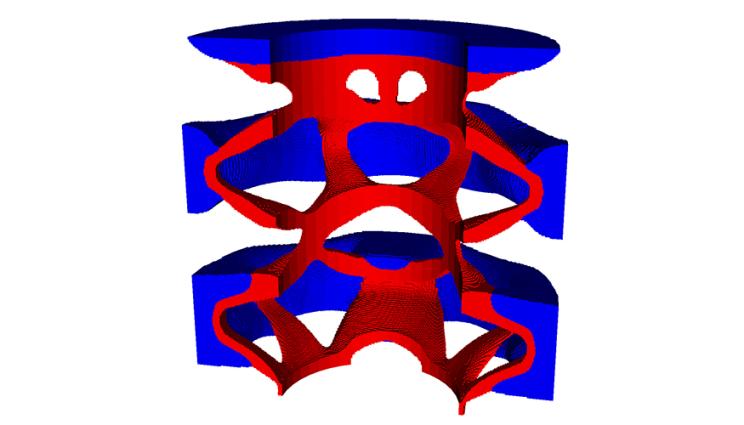
Lawrence Livermore National Laboratory engineer Kenny Swartz used the Serac wrapper to create this multi-material design, which shrinks along its axis when heated - a property not found in nature. This property occurs here because the two constituent materials form thermally-actuated mechanisms. From whiteboard sketches to final designs, the design was produced in about a week - exponentially faster than previous implementations, with the ability to quickly wrap custom Serac models as the key enabling step. Image courtesy of Kenny Swartz.
Lawrence Livermore National Laboraotry (LLNL) engineers have taken major strides towards closing the gap between the Lab's manufacturing and design capabilities. The field of additive manufacturing, or 3D printing, has enabled the manufacturing of a variety of heretofore impossible designs - but some of this potential is left on the table because designers have had trouble keeping up with additive manufacturing's pace of evolution.
Over the course of the last decade, LLNL has precipitated numerous advances in 3D printing, using materials from liquid metal to foam and creating both large machine parts and nanoscale technologies.
The Center for Design and Optimization (CDO) was established in 2016 to create a computing environment that could take advantage of advances in additive manufacturing. Using Lab Directed Research and Development (LDRD) funds and the Lab's high performance computing power, the Livermore Design Optimization (LiDO) code then came to fruition, largely thanks to the efforts of CDO Director Dan Tortorelli and computational engineer Dan White.
In the wake of the LDRD project that developed LiDO, efforts began to transition LiDO from a research code into a production tool. One major change that resulted from this effort was to replace LiDO's own engineering modeling and simulation with Serac, another LLNL code. Developed by the Smith project led by computational engineer Jaime Bramwell, Serac supports design sensitivity analysis, distinguishing it from production finite element codes at the Lab - that is, Serac is useful not only for simulating how a part will perform in service, but also efficiently predicting how its performance will change as the design is altered. LiDO works in tandem with Serac to automatically generate optimal designs once the performance metrics that define for a "good design" are input. This approach has been used to design everything from bridges and dams to unit cells of meta-materials, as well as programmatic components.
In December 2022, the LiDO team led by computational engineer Seth Watts, working with the Smith team achieved a milestone that makes generating designs with LiDO much faster and easier by making it simpler to define simulation problems using Serac. Previously, someone wanting to optimize a part simulated with Serac would have to write unique but largely boilerplate code that would integrate the simulation into the LiDO framework, and this code would require documentation and testing. Manually "wrapping" every Serac solver individually was labor intensive and limited designers' flexibility in using new features in Serac developed by the Smith team.
Now, all Serac solvers - including new solvers yet to be written by the Smith team - can use the same single wrapper. This change simplifies the LiDO code base, lets designers interact directly with Serac solvers to use the latest features as soon as they are available, reduces the code maintenance burden in LiDO, and - most importantly - removes the time and energy barriers to design optimization using Serac solvers.
Up next, the team is planning to simply how LiDO defines performance metrics using Smith and Serac tools, so that users can delineate these parameters with just a few lines of code. In combination, these updates will allow for a far more agile response to changing design needs.
-- Aimee Fountain






